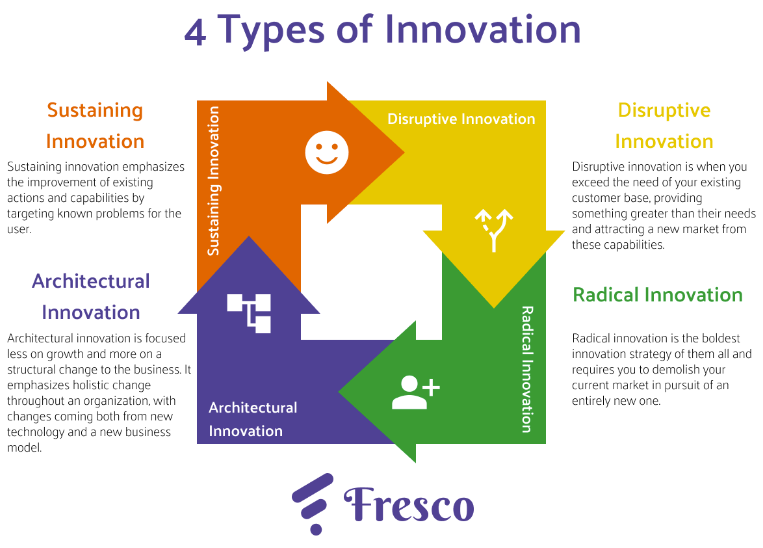By: Paul Van Zandt

Innovating doesn’t just happen when inspiration strikes. In order to ensure forward progress, a business has to create a structure that stimulates innovation regularly. This structure will determine the rate and efficacy of overall innovation and is commonly known as an innovation strategy. This article will define innovation strategy, discuss how to create one, and outline the main types of innovation.
What Is Innovation Strategy?
An innovation strategy is a plan that organizes future growth milestones in an effort to fill unmet customer needs. It will detail the value added to the product/service in the coming months and should evolve your business to better target an improved customer experience.
An innovation plan will consist of the policies, research methods, and strategies that are required to reach your targeted goals. It is essentially a business model for your innovation planning and will be a guide to improving your business’ innovative capital.
Innovation doesn’t just happen; it’s born out of a curated environment that emphasizes the deliberate development of new ideas. Creating an effective innovation mindset is essential for any organization that wants to create a competitive edge and makes planning for the future much more effective.
The customer needs you’re targeting will look very different based on the type of innovation your organization is pursuing. Under a sustainable innovation plan, you will be looking at the current users and their needs, but a radical innovation plan will focus on a completely different, untapped market to foster innovation potential there. To better understand the differences, we’ll outline the main types of innovation below.
Why Is Innovation Strategy Important?
An innovation strategy focuses on the core value of the business and how it can expand to meet increased customer needs or target a brand new market. Increasing value is one of the most important things a company can do to optimize customer retention. An innovation strategy can ensure your business is ahead of the curve and meets new customer need as it arises. Here are some of the reasons having an innovation strategy is essential.
- Clarifies Goals: Creating an innovation strategy helps formalize some of the most important goals within the business. When the organization’s goals are communicated, it helps prioritize what’s most important to the business and how your team can effectively reach them.
- Creates Alignment: Similar to clarifying goals, creating an innovation strategy helps create alignment at all levels of the business. Whether individual tasks, high-level strategy, or operations management, everyone will have a shared idea of the main goals and how they should reach them.
- Optimizes for long-term success: Instead of focusing solely on the immediate future, an innovation strategy clarifies the long-term strategic movement of the business. This provides meaning to the short-term tasks and gives the company a long trajectory to target over time.
- Fosters Collaboration: When innovation is at the center of a business, collaboration is required to move things forward. Creating an innovation strategy inherently emphasizes innovation between individuals, teams, and departments. This fosters the best environment for innovation to succeed.
Different Types of Innovation Strategy
Not all innovation is the same, and when developing an innovation strategy, you need to understand which type of innovation you will strive for. Here are the four major types of innovation.

Sustaining Innovation
Sustaining innovation is the most common type of innovation and focuses on improvement rather than replacement. This innovation type emphasizes the improvement of existing actions and capabilities by targeting known problems for the user.
Building on your existing capabilities and serving your current customer base is an important place to focus, and is usually very closely aligned with your company’s value. While sustaining innovation is always important, it has a lower ceiling than others and can seem stagnant after a more extended time.
Disruptive Innovation
Disruptive innovation is when you exceed the need of your existing customer base, providing something greater than their needs and attracting a new market from these capabilities.
Disruptive innovation can meet the needs of your existing users while also opening up a new market, but it is usually used to target an untapped market that will displace the existing one.
This innovation style can be worthwhile if done correctly, but it raises some uncertainty because it puts your existing user base’s status at risk. However, if you successfully pull it off, you are primed for increased growth in the coming months.
Radical Innovation
Radical innovation is the boldest innovation strategy of them all and requires you to demolish your current market in pursuit of an entirely new one. This type of innovation is usually a sign of a significant shift within an organization and can be indicative of a disruptive endeavor into a new market.
When conducting radical innovation, an organization needs to incorporate cutting-edge technology with an innovative business model to provide something that has never been done before. Completing a radical innovation is relatively rare but is extremely lucrative when pulled off successfully.
Architectural Innovation
Architectural innovation is focused less on growth and more on a structural change to the business. It emphasizes holistic change throughout an organization, with changes coming both from new technology and a new business model.
Architectural innovation can be very challenging to undertake due to the amount of internal and external change that’s required to complete it successfully. The pieces of this model are not necessarily innovative when isolated, but they are important agents of change that allow you to innovate your business as a whole.
How to Create an Innovation Strategy
Every innovation strategy will be different and will closely align with one of the types of innovation listed above. While each organization will have unique goals and different approaches, some best practices exist to create an innovation strategy that will help any business. Here are some crucial guideposts to follow when creating an innovation strategy.
Analyze Current Strategy
The first step to creating an innovation strategy is understanding where you stand currently and where you could most improve. This will be a key point when choosing the type of innovation you base your strategy on because you will need to determine if you will disrupt or address your target market.
Understanding your brand identity, customer value, and current focus is essential to creating an innovation strategy that fits your organization. During this process, it can be helpful to do some competitive analysis to determine where other players are evolving in your competitive ecosystem and how that could affect your future changes.
It’s important to conduct an internal analysis at the beginning because it lays the foundation for what kind of innovation strategy you choose and how you prioritize going forward.
Research Customer Needs
After determining your positioning, you must begin researching your customer’s needs. Understanding the changing needs of your customer base is critical to consistently delivering value through your product/service.
Depending on the innovation you’re focusing on, you might want to focus on different areas in relation to your customer’s needs. For example, if you’re creating a disruptive innovation strategy, you might briefly consider the needs of your existing user base but will focus heavily on your ideal target market, which has yet to be addressed.
These details will be crucial to developing value and messaging within your business, so it’s important you create a clear understanding of who your target market is and how you can successfully meet their needs.
Evolve your Value Proposition
After creating an outline of who your customers will be, you need to understand why they will choose your product/service. This is where your value proposition comes into the picture.
Your existing value proposition is meant to evolve as you create your innovation strategy. This statement will include the overall change in your business through your innovation but will also address why the customer will choose your product and what they will get from it. The value proposition of your innovation strategy should resemble the value you deliver with your final product.
This value shouldn’t be the same as it is currently, so make sure you understand how your innovation strategy differentiates your business and reflect that in your evolved value proposition.
Formalize Innovation Methods
The last piece to creating an innovation strategy is formalizing the techniques and methods that will go into making the strategy. To execute your innovation strategy consistently and efficiently, you need to understand how you can build each step to create a valuable end product.
The pieces that make up your innovation strategy will focus on the development, research, marketing, and communication of your new solutions. It’s important to narrow your innovation strategy down to the specific projects that will contribute to the overall goals you’re building towards. Collaborate with team leaders heads in R&D, development, and marketing to understand how you can make your goals actionable and achievable. This is the best thing you can do to ensure your innovation strategy is consistently built upon and improved over time.
Innovation Strategy Templates
Building an innovation strategy is easiest when done collaboratively with your team. In order to facilitate collaboration, there are a couple of templates that make creating an innovation strategy very straightforward.
Strategy Choice Cascade
The strategy choice cascade template allows you to create a holistic innovation strategy in an organized format. It breaks up each section of the business into its own group. It requires you to think about how each component interacts with one another, eventually creating a strategy that’s well-informed and fully integrated.
This template emphasizes the interaction between internal operations, showing how vital communication and alignment are to successful innovation.
If you want to learn more about the strategy choice cascade template, you can use it for free here.
CO-STAR
The CO-STAR board is an alternative business model that focuses on the value proposition of your business. When creating an innovation strategy, updating your value proposition is one of the core components of creating a vision for the future. The CO-STAR board can be extremely helpful in this area.
This template defines multiple internal and external factors that affect your business model and uses them to position your value proposition at the center of your business. By providing a centralized focus on your value proposition, the CO-STAR board allows you to build an innovation strategy grounded in your unique value and reach new customers based on this approach.
Innovation Ambition Matrix
The innovation ambition matrix is a template that helps determine which innovations should be part of the central business model and which should be part of a radical expansion. When creating an innovation strategy, understanding what kind of innovation you’re focusing on is important, and using an innovation ambition matrix can help clarify this decision.
You can learn more about the innovation ambition matrix by reading our popular article here.
Conclusion
Innovation is a critical part of success for any business, and optimizing it can be daunting in the absence of a robust innovation strategy. Hopefully, this guide has helped break down what an innovation strategy is, why it’s essential, and the first steps you can take to build one yourself.
